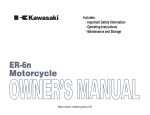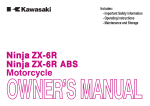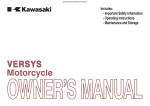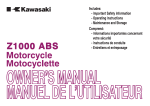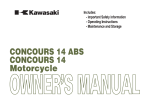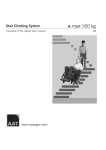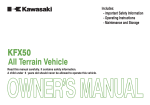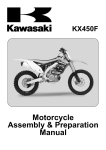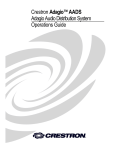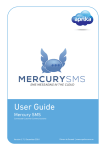Download K - OWNER`s Manual
Transcript
MAINTENANCE AND ADJUSTMENT 71 MAINTENANCE AND ADJUSTMENT The maintenance and adjustments outlined in this chapter must be carried out and must be done in accordance with the Periodic Maintenance Chart to keep the motorcycle in good running condition. The initial maintenance is vitally important and must not be neglected. With a basic knowledge of mechanics and the proper use of tools, you should be able to carry out many of the maintenance items described in this chapter. If you lack proper experience or doubt your ability, all adjustments, maintenance, and repair work should be completed by a qualified technician. Please note that Kawasaki cannot assume any responsibility for damage resulting from incorrect or improper adjustment done by the owner. 72 MAINTENANCE AND ADJUSTMENT EMISSION CONTROL INFORMATION To protect the environment in which we all live, Kawasaki has incorporated crankcase emission (1) and exhaust emission (2) control systems in compliance with applicable regulations of the United States Environmental Protection Agency and California Air Resources Board. Additionally, Kawasaki has incorporated an evaporative emission control system (3) in compliance with applicable regulations of the United States Environmental Protection Agency. 1. Crankcase Emission Control System This system eliminates the release of crankcase vapors into the atmosphere. Instead, the vapors are routed through an oil separator to the intake side of the engine. While the engine is operating, the vapors are drawn into the combustion chamber, where they are burned along with the fuel and air supplied by the fuel injection system. 2. Exhaust Emission Control System This system reduces the amount of pollutants discharged into the atmosphere by the exhaust of this motorcycle. The fuel, ignition and exhaust systems of this motorcycle have been carefully designed and constructed to ensure an efficient engine with low exhaust pollutant levels. The exhaust system of this model motorcycle includes a catalytic converter system. MAINTENANCE AND ADJUSTMENT 73 3. Evaporative Emission Control System The evaporative emission control system for this vehicle consists of low permeation fuel hoses and a fuel tank. 3. Evaporative Emission Control System (California) Vapors caused by fuel evaporation in the fuel system are not vented into the atmosphere. Instead, fuel vapors are routed into the running engine to be burned, or stored in a canister when the engine is stopped. Liquid fuel is caught by a vapor separator and returned to the fuel tank. High Altitude Performance Adjustment Information High altitude adjustment is not required. 74 MAINTENANCE AND ADJUSTMENT MAINTENANCE AND WARRANTY Proper maintenance is necessary to ensure that your motorcycle will continue to have low emission levels. This Owner's Manual contains those maintenance recommendations for your motorcycle. Those items identified by the Periodic Maintenance Chart are necessary to ensure compliance with the applicable standards. As the owner of this motorcycle, you have the responsibility to make sure that the recommended maintenance is carried out according to the instructions in this Owner's Manual at your own expense. The Kawasaki Limited Emission Control System Warranty requires that you return your motorcycle to an authorized Kawasaki dealer for remedy under warranty. Please read the warranty carefully, and keep it valid by complying with the owner's obligations it contains. You should keep a maintenance record for your motorcycle. To assist you in keeping this record, we have provided space on pages 160 through 165 of this manual where an authorized Kawasaki dealer, or someone equally competent, can record the maintenance. You should also retain copies of maintenance work orders, bills, etc., as verification of this maintenance. MAINTENANCE AND ADJUSTMENT 75 TAMPERING WITH NOISE CONTROL SYSTEM PROHIBITED: Federal law prohibits the following acts or the causing thereof: (1) the removal or rendering inoperative by any person other than for purposes of maintenance, repair, or replacement, of any device or element of design incorporated into any new vehicle for the purpose of noise control prior to its sale or delivery to the ultimate purchaser or while it is in use, or (2) the use of the vehicle after such device or element of design has been removed or rendered inoperative by any person. Among those acts presumed to constitute tampering are the acts listed below: Replacement of the original exhaust system or muffler with a component not in compliance with Federal regulations. * Removal of the muffler(s) or any internal portion of the muffler(s). * Removal of the air box or air box cover. * Modifications to the muffler(s) or air intake system by cutting, drilling, or other means if such modifications result in increased noise levels. * 76 MAINTENANCE AND ADJUSTMENT Periodic Maintenance Chart K : Should be serviced by an authorized Kawasaki dealer. * : For higher odometer readings, repeat at the frequency interval established here. # : Service more frequently when operating in severe conditions: dusty, wet, muddy, high speed, or frequent starting/stopping. 1. Periodic Inspection (Engine Related Items) Frequency Whichever comes first Operation (Engine Items) Valve clearance inspect Throttle control system (play, smooth return, no drag) - inspect Idle speed - inspect Every *Odometer Reading km × 1 000 (mile × 1 000) See Page 1 6 12 18 24 30 36 (0.6) (3.75) (7.5) (11.25) (15) (18.75) (22.5) • year 104 • • • • 107 • • • • 110 MAINTENANCE AND ADJUSTMENT 77 Frequency Whichever comes first Operation (Engine Items) Fuel leak (fuel K hose and pipe) inspect K Every *Odometer Reading km × 1 000 (mile × 1 000) See Page 1 6 12 18 24 30 36 (0.6) (3.75) (7.5) (11.25) (15) (18.75) (22.5) year • • • • – year • • • • – year • • • • – Coolant leak - inspect year Radiator hose damage - inspect year • • • • • • • • • • • • Fuel hoses damage - inspect Fuel hoses inK stallation condition - inspect Coolant level - inspect 99 – 96 78 MAINTENANCE AND ADJUSTMENT Frequency Whichever comes first Operation (Engine Items) Radiator hoses installation condition - inspect Every year *Odometer Reading km × 1 000 (mile × 1 000) See Page 1 6 12 18 24 30 36 (0.6) (3.75) (7.5) (11.25) (15) (18.75) (22.5) • Air suction system damage - inspect Evaporative emission control system - function (California model only) • • • • • 96 • • • 104 • 103 • • • • MAINTENANCE AND ADJUSTMENT 79 2. Periodic Inspection (Chassis Related Items) Frequency Whichever comes first Operation (Chassis Items) Clutch and drive train: Every Clutch operation (play, engagement, disengagement) inspect K Drive belt deflection - inspect K Drive belt wear inspect *Odometer Reading km × 1 000 (mile × 1 000) See Page 1 6 12 18 24 30 36 (0.6) (3.75) (7.5) (11.25) (15) (18.75) (22.5) • • • • • • • • • • • • • • • • • • 111 102 102 Wheels and tires: Tire air pressure - inspect year • • • 124 80 MAINTENANCE AND ADJUSTMENT Frequency Whichever comes first Operation (Chassis Items) Wheels/tires damage - inspect Every *Odometer Reading km × 1 000 (mile × 1 000) See Page 1 6 12 18 24 30 36 (0.6) (3.75) (7.5) (11.25) (15) (18.75) (22.5) Tire tread wear, abnormal wear inspect Wheel bearings K damage - inspect year • • • 126 • • • 126 • • • – Brake system: Brake fluid leak inspect Brake hoses K damage - inspect year • • • • • • • 114 year • • • • • • • 114 MAINTENANCE AND ADJUSTMENT 81 Frequency Whichever comes first Operation (Chassis Items) Brake pad wear inspect # Every *Odometer Reading km × 1 000 (mile × 1 000) See Page 1 6 12 18 24 30 36 (0.6) (3.75) (7.5) (11.25) (15) (18.75) (22.5) • • • • • • 114 • • • • • • • 114 Brake fluid level 6 month inspect • • • • • • • 115 Brake operation (effectiveness, play, drag) - inspect • • • • • • • 117 • • • • • • • 118 Brake hose inK stallation condition - inspect Brake light switch operation - inspect year year 82 MAINTENANCE AND ADJUSTMENT Frequency Whichever comes first Operation (Chassis Items) Suspensions: Every Front forks/rear shock absorber K operation (damping and smooth stroke) - inspect Front forks/rear K shock absorber oil leak - inspect K year *Odometer Reading km × 1 000 (mile × 1 000) See Page 1 6 12 18 24 30 36 (0.6) (3.75) (7.5) (11.25) (15) (18.75) (22.5) • • • – • • • – • Swing arm pivot - lubricate Uni-trak rocker K arm operation inspect • • – • – MAINTENANCE AND ADJUSTMENT 83 Frequency Whichever comes first Operation (Chassis Items) Uni-trak tie rods K operation - inspect Every *Odometer Reading km × 1 000 (mile × 1 000) See Page 1 6 12 18 24 30 36 (0.6) (3.75) (7.5) (11.25) (15) (18.75) (22.5) • • • – Uni-trak rocker K arm bearings lubricate • – Uni-trak tie rods K bearings - lubricate • – Steering system: K Steering play inspect Steering stem K bearings - lubricate year 2 years • • • • • – – 84 MAINTENANCE AND ADJUSTMENT Frequency Whichever comes first Operation (Chassis Items) Electrical system: Every *Odometer Reading km × 1 000 (mile × 1 000) See Page 1 6 12 18 24 30 36 (0.6) (3.75) (7.5) (11.25) (15) (18.75) (22.5) Lights and switches operation - inspect year • • • – Headlight aiming - inspect year • • • 135 Side stand switch operation - inspect year • • • – Engine stop switch operation - inspect year • • • – year • • • 139 Chassis: Chassis parts lubricate MAINTENANCE AND ADJUSTMENT 85 Frequency Whichever comes first Operation (Chassis Items) Bolts and nuts tightness - inspect Every *Odometer Reading km × 1 000 (mile × 1 000) See Page 1 6 12 18 24 30 36 (0.6) (3.75) (7.5) (11.25) (15) (18.75) (22.5) • • • • 146 86 MAINTENANCE AND ADJUSTMENT 3. Periodic Replacement Frequency Whichever comes first Change/Replacement Items K Air cleaner element # - replace Every *Odometer Reading km × 1 000 (mile × 1 000) 1 12 24 36 48 (0.6) (7.5) (15) (22.5) (30) every 18 000 km (12 000 mile) Engine oil # - change year Oil filter - replace year K Fuel hoses - replace 4 years K Coolant - change 3 years Radiator hoses and O-rings - reK place 3 years K Brake hoses - replace 4 years K Brake fluid (front and rear) change 2 years K Rubber parts of master cylinder and caliper - replace 4 years See Page • • • • • • • • • • • • • • 106 90 90 – 101 – • • • – 117 – MAINTENANCE AND ADJUSTMENT 87 Frequency Whichever comes first Change/Replacement Items K Spark plug - replace Every *Odometer Reading km × 1 000 (mile × 1 000) See Page 1 12 24 36 48 (0.6) (7.5) (15) (22.5) (30) • • • • 102 88 MAINTENANCE AND ADJUSTMENT Engine Oil In order for the engine, transmission, and clutch to function properly, maintain the engine oil at the proper level, and change the oil and replace the oil filter in accordance with the Periodic Maintenance Chart. Not only do dirt and metal particles collect in the oil, but the oil itself loses its lubricative quality if used too long. WARNING Motorcycle operation with insufficient, deteriorated, or contaminated engine oil will cause accelerated wear and may result in engine or transmission seizure, accident, and injury. Check the oil level before each ride and change the oil according to the periodic maintenance chart in the Owner’s Manual. Oil Level Inspection If the oil has just been changed, start the engine and run it for several minutes at idle speed. This fills the oil filter with oil. Stop the engine, then wait several minutes until the oil settles. • NOTICE Racing the engine before the oil reaches every part can cause engine seizure. MAINTENANCE AND ADJUSTMENT 89 motorcycle has just been used, • Ifwaittheseveral minutes for all the oil to the oil level is too high, remove the • Ifexcess oil through the oil filler open- drain down. Check the engine oil level through the oil level gauge. With the motorcycle held level, the oil level should come up between the upper and lower level lines next to the gauge. ing using a syringe or some other suitable device. If the oil level is too low, add the oil to reach the correct level. Use the same type and brand of oil that is already in the engine. • • NOTICE If the engine oil gets extremely low or if the oil pump does not function properly or oil passages are clogged, the warning light in the speedometer will light. If this light stays on when the engine speed is above the idle speed, stop the engine immediately and find the cause. A. Oil Filler Gauge B. Oil Filler Cap C. Upper Level Line D. Low Level Line 90 MAINTENANCE AND ADJUSTMENT Oil and/or Oil Filter Change Warm up the engine thoroughly, and then stop it. Place an oil pan beneath the engine. Remove the engine oil drain plug. • • • A. Oil Pressure Warning Light A. Engine Oil Drain Plug the oil completely drain with the • Let motorcycle perpendicular to the ground. MAINTENANCE AND ADJUSTMENT 91 WARNING • Remove the regulator/rectifier. Motor oil is a toxic substance. Dispose of used oil properly. Contact your local authorities for approved disposal methods or possible recycling. • Remove the cover. A. Regulator/Rectifier B. Bolt A. Cover B. Bolt 92 MAINTENANCE AND ADJUSTMENT • Remove the bracket. the oil filter cartridge and re• Remove place it with a new one. A. Bracket B. Bolt A. Cartridge NOTE ○ If a torque wrench or required Kawasaki special tool is not available, this item should be serviced by an authorized Kawasaki dealer. a thin film of oil to the packing • Apply and tighten the cartridge to the specified torque. MAINTENANCE AND ADJUSTMENT 93 the engine up to the upper level • Fill line with a good quality engine oil • • • specified in the table. Start the engine. Check the oil level and for oil leakage. Be sure to install the parts removed. Tightening Torque Engine Drain Plug: 20 N·m (2.0 kgf·m, 14.5 ft·lb) Cartridge: 18 N·m (1.8 kgf·m, 13 ft·lb) Regulator/Rectifier Bolt: A. Packing • 7 N·m (0.7 kgf·m, 5.2 ft·lb) Install the engine oil drain plug with a new gasket and tighten it to the specified torque. NOTE ○ Replace any gasket with a new one. 94 MAINTENANCE AND ADJUSTMENT Recommended Engine Oil Type: Kawasaki Performance 4Stroke Motorcycle Oil* Kawasaki Performance 4Stroke Semi-Synthetic Oil* Kawasaki Performance 4Stroke Full Synthetic Oil* or other 4-stroke oils with API SG, SH, SJ, SL, SM and JASO MA, MA1, MA2 rating Viscosity: SAE 10W-40 NOTE ○ Do not add any chemical additive to the oil. Oils fulfilling the above requirements are fully formulated and provide adequate lubrication for both the engine and the clutch. Engine Oil Capacity Capacity: 3.0 L (3.2 US qt) [when filter is not removed] 3.2 L (3.4 US qt) [when filter is removed] 3.7 L (3.9 US qt) [when engine is completely dry] MAINTENANCE AND ADJUSTMENT 95 Although 10W-40 engine oil is the recommended oil for most conditions, the oil viscosity may need to be changed to accommodate atmospheric conditions in your riding area. Cooling System Radiator and Cooling Fin Check the radiator fins for obstruction by insects or mud. Clean off any obstructions with a stream of low-pressure water. WARNING The cooling fan spins at high speed and can cause serious injuries. Keep your hands and clothing away from the cooling fan blades at all times. *Kawasaki Performance Oils and Lubricants have been specifically engineered for your vehicle. Consistent use of these products meets or exceeds warranty and service requirements and can help to extend the life of your Kawasaki. 96 MAINTENANCE AND ADJUSTMENT NOTICE Using high-pressure water, as from a car wash facility, could damage the radiator fins and impair the radiator's effectiveness. Do not obstruct or deflect airflow through the radiator by installing unauthorized accessories in front of the radiator or behind the cooling fan. Interference with the radiator airflow can lead to overheating and consequent engine damage. Radiator Hoses Check the radiator hoses for leakage, cracks or deterioration, and connections for leakage, or looseness each day before riding the motorcycle, and in accordance with the Periodic Maintenance Chart. Coolant Coolant absorbs excessive heat from the engine and transfers it to the air at the radiator. If the coolant level becomes low, the engine overheats and may suffer severe damage. Check the coolant level each day before riding the motorcycle, also in accordance with the periodic maintenance chart and replenish coolant if the level is low. Change the coolant in accordance with the Periodic Maintenance Chart. Information for Coolant To protect the cooling system (consisting of the aluminum engine and radiator) from rust and corrosion, the use of corrosion and rust inhibitor chemicals in the coolant is essential. If coolant containing corrosion and rust inhibitor chemicals are not used, over a period of time, the cooling system accumulates rust and scale in the water jacket and radiator. This will clog up MAINTENANCE AND ADJUSTMENT 97 the coolant passages, and considerably reduce the efficiency of the cooling system. WARNING Coolant containing corrosion inhitors for alminum engines and radiators include harmful chemicals for human body. Drinking coolant can result in serious injury or death. Use coolant in accordance with the instractions of the manufacturer. Soft or distilled water must be used with the antifreeze (see below for antifreeze) in the cooling system. NOTICE If hard water is used in the system, it causes scale accumulation in the water passages, and considerably reduces the efficiency of the cooling system. If the lowest ambient temperature encountered falls below the freezing point of water, use permanent antifreeze in the coolant to protect the cooling system against engine and radiator freeze-up, as well as from rust and corrosion. Use a permanent type of antifreeze (soft water and ethylene glycol plus corrosion and rust inhibitor chemicals for aluminum engines and radiators) in the cooling system. On the mixture ratio of coolant, choose the suitable one referring to the relation between 98 MAINTENANCE AND ADJUSTMENT freezing point and strength directed on the container. NOTICE Permanent types of antifreeze on the market have anti-corrosion and anti-rust properties. When it is diluted excessively, it loses its anti-corrosion property. Dilute a permanent type of antifreeze in accordance with the instructions of the manufacturer. NOTE ○ A permanent type of antifreeze is in- stalled in the cooling system when shipped. It is colored green and contains ethylene glycol. It is mixed at 50% and has the freezing point of −35°C (−31°F). Coolant Level Inspection Situate the motorcycle so that it is perpendicular to the ground. Check the coolant level through the coolant level gauge. The coolant level should be between the F (Full) and L (Low) marks. • • NOTE ○ Check the level when the engine is cold (room or atmospheric temperature). MAINTENANCE AND ADJUSTMENT 99 Coolant Filling Remove the seat. Remove the left side cover by removing the screw. • • A. F (Full) Level Line B. L (Low) Level Line C. Reserve Tank the amount of coolant is insuffi• Ifcient, add coolant. A. Screw B. Left Side Cover 100 MAINTENANCE AND ADJUSTMENT • Remove the reservoir tank cover. the cap from the reservoir • Open tank, and add coolant through the filler opening to the F (Full) mark. A. Reservoir Tank Cover B. Bolt A. Reserve Tank B. Reserve Tank Cap the cap after filling coolant. • Install Install the parts removed. • MAINTENANCE AND ADJUSTMENT 101 ○ When NOTE installing the left side cover, be sure to insert the projections of the left side cover to each holes. correct mixture ratio by the addition of antifreeze concentrate as soon as possible. NOTICE If coolant must be added often, or the reserve tank completely runs dry, there is probably leakage in the system. Have the cooling system inspected by your authorized Kawasaki dealer. Coolant Change Have the coolant changed by an authorized Kawasaki dealer. A. Projections B. Left Side Cover NOTE ○ In an emergency you can add water alone to the coolant reserve tank, however it must be returned to the 102 MAINTENANCE AND ADJUSTMENT Drive Belt Spark Plugs In order for the belt and belt pulleys to function properly, check the drive belt in accordance with the Periodic Maintenance Chart. Belt check and adjustment should be done by an authorized Kawasaki dealer. The standard spark plug is shown in the table. The spark plugs should be replaced in accordance with the Periodic Maintenance Chart. Spark plug removal should be done by a competent mechanic following the instructions in the Service Manual. NOTICE Improper drive belt deflection can result in belt damage. Spark Plug Standard Plug NGK CPR7EA-9 Plug Gap 0.8 ~ 0.9 mm (0.032 ~ 0.036 in.) Tightening Torque 18 N·m (1.8 kgf·m, 13 ft·lb) ○ Fit NOTE the plug cap securely onto the spark plug, and pull the cap lightly to make sure that it is properly installed. MAINTENANCE AND ADJUSTMENT 103 Evaporative Emission Control System (California model only) This system routes fuel vapors from the fuel system into the running engine or stores the vapors in a canister when the engine is stopped. Although no adjustments are required, a thorough visual inspection must be made at the intervals specified by the Periodic Maintenance Chart. Inspection that the hoses are securely • Check connected. any kinked, deteriorated, or • Replace damaged hoses. 104 MAINTENANCE AND ADJUSTMENT Valve Clearance Kawasaki Clean Air System Valve and valve seat wear decreases valve clearance, upsetting valve timing. The Kawasaki Clean Air System (KCA) is a secondary air suction system that helps the exhaust gases to burn more completely. When the spent fuel charge is released into the exhaust system, it is still hot enough to burn. The KCA System allows extra air into the exhaust system so that the spent fuel charge can continue to burn. This continued burning action tends to burn up a great deal of the normally unburned gases, as well as changing a significant portion of the carbon monoxide into carbon dioxide. NOTICE If valve clearance is left unadjusted, wear will eventually cause the valves to remain partly open; which lowers performance, burns the valves and valve seats, and may cause serious engine damage. Valve clearance for each valve should be checked and adjusted in accordance with the Periodic Maintenance Chart. Inspection and adjustment should be done by a competent mechanic following the instructions in the Service Manual. Air Suction Valves The air suction valve is essentially a check valve which allows fresh air to flow only from the air cleaner into the exhaust port. Any air that has passed the air suction valve is prevented from returning. Inspect the air suction valves MAINTENANCE AND ADJUSTMENT 105 in accordance with the Periodic Maintenance Chart. Also, inspect the air suction valves whenever stable idling cannot be obtained, engine power is greatly reduced, or there are abnormal engine noise. Air suction valve removal and inspection should be done by a competent mechanic following the instructions in the Service Manual. Air Cleaner A clogged air cleaner restricts the engine's air intake, increasing fuel consumption, reducing engine power, and causing spark plug fouling. The air cleaner element must be replaced in accordance with the Periodic Maintenance Chart. This motorcycle's air cleaner element consists of a wet paper filter, which can not be cleaned. In dusty, rainy, or on muddy conditions, the air cleaner element should be serviced more frequently than the recommended interval. 106 MAINTENANCE AND ADJUSTMENT Element Removal Remove the bolts of the air cleaner cover located on the right-side of the engine. • A. Air Cleaner Cover B. Bolt the air cleaner screw and • Remove the air cleaner. If any part of the element is damaged, the element must be replaced. A. Air Cleaner Element B. Air Cleaner C. Screw MAINTENANCE AND ADJUSTMENT 107 WARNING If dirt or dust is allowed to pass through into the fuel injection system, the throttle may stick or become inoperable resulting in a hazardous operating condition. NOTICE If dirt gets through into the engine, excessive engine wear and possibly engine damage will occur. NOTE ○ Element installation is performed in the reverse order of removal. Throttle Control System Check the throttle grip play, in accordance with the Periodic Maintenance Chart, and adjust the throttle grip play. Throttle Grip The throttle grip controls the butterfly valves in the throttle body. If the throttle grip has excessive play due to either cable stretch or maladjustment, it will cause a delay in throttle response, especially at low engine speed. Also, the throttle valve may not open fully at full throttle. On the other hand, if the throttle grip has no play, the throttle will be hard to control, and idle speed will be erratic. 108 MAINTENANCE AND ADJUSTMENT Inspection Check that there is 2 ~ 3 mm (0.08 ~ 0.12 in.) throttle grip play when lightly turning the throttle grip back and forth. • Adjustment Loosen the locknuts at the upper ends of the throttle cables, and screw both throttle cable adjusting nuts in completely so as to give the throttle grip plenty of play. Turn out the decelerator cable adjusting nut until there is no play when the throttle grip is completely closed. Tighten the locknut. • • A. Throttle Grip B. 2 ~ 3 mm (0.08 ~ 0.12 in.) • If there is improper play, adjust it. MAINTENANCE AND ADJUSTMENT 109 the accelerator cable adjusting • Turn nut until 2 ~ 3 mm (0.08 ~ 0.12 in.) of • A. Accelerator Cable B. Decelerator Cable C. Adjusting Nuts D. Locknuts throttle grip play is obtained. Tighten the locknut. If the throttle cables cannot be adjusted by using the cable adjusting nuts at the upper ends of the throttle cables, further adjustment of the throttle cables should be done by a competent mechanic following the instructions in the Service Manual. WARNING Operation with improperly adjusted, incorrectly routed, or damaged cables could result in an unsafe riding condition. Be sure the control cables are adjusted and routed correctly, and are free from damage. 110 MAINTENANCE AND ADJUSTMENT Idle Speed The idle adjustment should be performed in accordance with the Periodic Maintenance Chart or whenever the idle speed is disturbed. Adjustment Start the engine, and warm it up thoroughly. Wait until the idle speed drops before making the following adjustment. Adjust the idle speed to 950 ~ 1 050 r/min (rpm) by turning the idle adjusting screw located at the right front cylinder. • • • A. Idle Speed Adjusting Screw and close the throttle a few • Open times to make sure that the idle • speed does not change. Readjust if necessary. With the engine idling, turn the handlebar to each side. If handlebar movement changes the idle speed, the throttle cables may be improperly adjusted or incorrectly routed, or they may be damaged. Be sure to correct any of these conditions before riding. WARNING Operation with damaged cables could result in an unsafe riding condition. Replace damaged control cables before operation. MAINTENANCE AND ADJUSTMENT 111 Clutch Due to friction plate wear and clutch cable stretch over a long period of use, the clutch must be adjusted in accordance with the Periodic Maintenance Chart. WARNING The engine and exhaust system get extremely hot during normal operation and can cause serious burns. Never touch a hot engine or an exhaust pipe during clutch adjustment. 112 MAINTENANCE AND ADJUSTMENT Inspection Check that the clutch lever has 2 ~ 3 mm (0.08 ~ 0.12 in.) of play as shown in the figure. • A. Locknut B. Adjuster C. 2 ~ 3 mm (0.08 ~ 0.12 in.) If the play is incorrect, adjust the lever play as follows. Adjustment WARNING Too much cable play can prevent clutch disengagement and cause an accident resulting in serious injury or death. When adjusting the clutch or replacing the cable, be sure the upper end of the clutch outer cable is fully seated in its fitting, or it could slip into place later, creating enough cable play to prevent clutch disengagement. the adjuster so that the clutch • Turn lever will have 2 ~ 3 mm (0.08 ~ 0.12 • in.) of play. If it cannot be done, use the nuts at the middle of the clutch cable. A. Locknut B. Clutch Cable C. Adjuster ○ After NOTE the adjustment is made, start the engine and check that the clutch MAINTENANCE AND ADJUSTMENT 113 does not slip and that it releases properly. ○ For minor corrections, use the adjuster at the clutch lever. 114 MAINTENANCE AND ADJUSTMENT Brakes Brake Wear Inspection Inspect the brakes for wear. For each front and rear disc brake caliper, if the thickness of either pad is less than 1 mm (0.04 in), replace both pads in the caliper as a set. Pad replacement should be done by an authorized Kawasaki dealer. Disc Brake Fluid In accordance with the Periodic Maintenance Chart, inspect the brake fluid level in both the front and rear brake fluid reservoirs and change the brake fluid. The brake fluid should also be changed if it becomes contaminated with dirt or water. Fluid Requirement Use heavy-duty brake fluid only from a container marked DOT4 . NOTICE A. Lining Thickness B. 1 mm (0.04 in.) Do not spill brake fluid onto any painted surface. Do not use fluid from a container that has been left open or that has been unsealed for a long time. Check for fluid leakage around the fittings. Check brake hose for damage. MAINTENANCE AND ADJUSTMENT 115 Fluid Level Inspection The brake fluid level in the front brake fluid reservoir must be kept above the line (lower level line) next to the gauge and that in the rear brake fluid reservoir (located near the brake pedal) must be kept between the upper and lower level lines (reservoirs held horizontal). • A. Rear Brake Fluid Reservoir B. Cover C. Upper Level Line D. Lower Level Line A. Front Brake Fluid Reservoir B. Lower Level Line 116 MAINTENANCE AND ADJUSTMENT the fluid level in either reservoir is • Iflower than the lower level line, check for fluid leaks in the brake lines, and fill the reservoir to the upper level line. Inside the front brake fluid reservoir is a stepped line showing the upper level line. For the rear reservoir, take off the bolt and remove the cover from the reservoir. A. Front Brake Fluid Reservoir B. Upper Level Line WARNING Mixing brands and types of brake fluid can reduce the brake system’s effectiveness and cause an accident resulting in injury or death. Do not mix two brands of brake fluid. Change the brake fluid in the brake line completely if the brake fluid must be refilled but the type and brand of the brake fluid that is already in the reservoir are unidentified. MAINTENANCE AND ADJUSTMENT 117 NOTE ○ First, tighten until slight resistance is felt indicating that the cap is seated on the reservoir body; then, tighten the cap an additional 1/6 turn while holding the brake fluid reservoir body. Fluid Change Have the brake fluid changed by an authorized Kawasaki dealer. Front and Rear Brakes Disc and disc pad wear is automatically compensated for and has no effect on the brake lever or pedal action. So there are no parts that require adjustment on the front and rear brakes. WARNING A. Reservoir B. Cap C. Clockwise D. 1/6 turn Air in the brake lines diminish braking performance and can cause an accident resulting in injury or death. If the brake lever or pedal feels mushy when it is applied, there might be air in the brake lines or the brake may be defective. Have the brake checked immediately by an authorized Kawasaki dealer. 118 MAINTENANCE AND ADJUSTMENT Brake Light Switches When either the front or rear brake is applied, the brake light goes on. The front brake light switch requires no adjustment, but the rear brake light switch should be adjusted in accordance with the Periodic Maintenance Chart. Inspection Turn the ignition key to “ON”. The brake light should go on when the front brake is applied. If it does not, ask your authorized Kawasaki dealer to inspect the front brake light switch. • • • the operation of the rear • Check brake light switch by depressing the brake pedal. The brake light should go on after about 10 mm (0.4 in.) of pedal travel. A. Brake Pedal B. 10 mm (0.4 in.) not, adjust the rear brake • Iflightit does switch. MAINTENANCE AND ADJUSTMENT 119 Adjustment To adjust the rear brake light switch, move the switch up or down by turning the adjusting nut. • A. Rear Brake Light Switch B. Adjusting Nut C. Lights sooner. D. Lights later. 120 MAINTENANCE AND ADJUSTMENT NOTICE To avoid damaging the electrical connections inside the switch, be sure that the switch body does not turn during adjustment. Rear Shock Absorber The rear shock absorber can be adjusted by changing the spring preload for various riding and loading conditions. MAINTENANCE AND ADJUSTMENT 121 Spring Preload Adjustment The rear shock absorber spring preload adjuster has 7 positions. Remove the left side cover and reservoir tank cover (see “Cooling System” section in this chapter). Remove the reservoir tank. • ○ When NOTE removing the reservoir tank, hook the under part of the reservoir tank to the holder of the frame as shown in the figure. • A. Under Part of Reservoir Tank B. Holder A. Reservoir Tank B. Bolt 122 MAINTENANCE AND ADJUSTMENT with the following ta• Inble,accordance turn the preload adjuster with the with no passenger and no accessories is No. 4. wrench from the tool kit. ○ This NOTE motorcycle has two hook wrenches in the tool kit. When changing the spring preload of the rear shock absorber, turn the adjuster by using the suitable hook wrenches. A. Spring Preload Adjuster B. Wrench Position 1 2 Spring Action —→ 3 4 5 6 7 Strong The standard setting position for an average-build rider of 68 kg (150 lb) A. Hook Wrench B. Extension Bar MAINTENANCE AND ADJUSTMENT 123 Wheels Tubeless tires are installed on the wheels of this motorcycle. The indications of TUBELESS on the tire side wall and the rim show that the tire and rim are specially designed for tubeless use. A. TUBELESS Mark The tire and rim form a leakproof unit by making airtight contacts at the tire chamfers and the rim flanges instead of using an inner tube. A. TUBELESS Mark 124 MAINTENANCE AND ADJUSTMENT WARNING Installing a tube inside a tubeless-type tire can create excessive heat build up that can damage the tube and cause rapid deflation. The tires, rims, and air valves on this motorcycle are designed only for tubeless type wheels. The recommended standard tires, rims, and air valves must be used for replacement. Do not install tube-type tires on tubeless rims. The beads may not seat properly on the rim causing tire deflation. Do not install a tube inside a tubeless tire. Excessive heat build-up may damage the tube causing tire deflation. Tires Payload and Tire Pressure Failure to maintain proper inflation pressures or observe payload limits for your tires may adversely affect handling and performance of your motorcycle and can result in loss of control. The maximum recommended load in addition to vehicle weight is 180 kg (397 lb), including rider, passenger, baggage, and accessories. the air valve cap. • Remove Check the pressure often, using • an accuratetiregauge. sure that the air valve cap is • Make securely installed. A. Tire Pressure Gauge NOTE ○ Measure the tire pressure when the tires are cold (that is, when the MAINTENANCE AND ADJUSTMENT 125 motorcycle has not been ridden more than a mile during the past 3 hours). ○ Tire pressure is affected by changes in ambient temperature and altitude, and so the tire pressure should be checked and adjusted when your riding involves wide variations in temperature or altitude. Tire Air Pressure (when cold) Up to 180 kg 280 kPa Front (397 lb) Load (2.80 kgf/cm², 40 psi) Up to 97.5 kg 200 kPa (215 lb) Load (2.00 kgf/cm², 28 psi) Rear 97.5 ~ 180 kg 225 kPa (215 ~ 397 lb) (2.25 kgf/cm², 32 psi) Load 126 MAINTENANCE AND ADJUSTMENT Tire Wear, Damage As the tire tread wears down, the tire becomes more susceptible to puncture and failure. An accepted estimate is that 90% of all tire failures occur during the last 10% of tread life (90% worn). So it is false economy and unsafe to use the tires until they are bald. accordance with • InMaintenance Chart, the Periodic measure the depth of the tread with a depth gauge, and replace any tire that has worn down to the minimum allowable tread depth. A. Tire Depth Gauge MAINTENANCE AND ADJUSTMENT 127 Minimum Tread Depth Front Rear — 1 mm (0.04 in.) Under 130 km/h (80 mph) 2 mm (0.08 in.) Over 130 km/h (80 mph) 3 mm (0.12 in.) inspect the tire for cracks • Visually and cuts, replacing the tire in case of • bad damage. Swelling or high spots indicate internal damage, requiring tire replacement. Remove any imbedded stones or other foreign particles from the tread. ○ Have NOTE the wheel balance inspected whenever a new tire is installed. WARNING Tires that have been punctured and repaired do not have the same capabilities as undamaged tires and can suddenly fail, causing an accident resulting in serious injury or death. Replace damaged tires as soon as possible. To ensure safe handling and stability, use only the recommended standard tires for replacement, inflated to the standard pressure. If it is necessary to ride on a repaired tire, do not exceed 100 km/h (60 mph) until the tire is replaced. NOTE ○ When operating on public roadways, keep maximum speed under traffic law limits. 128 MAINTENANCE AND ADJUSTMENT ○ Most counters may have their own regulations requiring a minimum tire thread depth; be sure to follow them. Standard Tire (Tubeless) Front Rear 80/90-21 M/C48H • DUNLOP “D404FJ” 180/70-15 M/C 76H • DUNLOP “D404” WARNING Mixing tire brands and types can adversely affect handling and cause an accident resulting in injury or death. Always use the same manufacturer's tires on both front and rear wheels. WARNING New tires are slippery and may cause loss of control and injury. A break-in period of 160 km (100 miles) is necessary to establish normal tire traction. During break-in, avoid sudden and maximum braking and acceleration, and hard cornering. MAINTENANCE AND ADJUSTMENT 129 Battery The battery installed in this vehicle is a sealed type, and the sealing strip should not be removed at any time after the specified electrolyte has been installed in the battery for initial service. It is not necessary to check the battery electrolyte level or add distilled water. However, in order to maximize battery life and ensure that it will provide the power needed to start the motorcycle you must properly maintain the battery's charge. When used regularly, the charging system in the motorcycle helps keep the battery fully charged. If the motorcycle is only used occasionally or for short periods of time, the battery is more likely to discharge. Due to their internal composition, batteries continually self discharge. The discharge rate depends on the type of battery and ambient temperature. As temperatures rise, so does the discharge rate. Every 15°C (27°F) doubles the rate. Electrical accessories, such as digital clocks and computer memory, also draw current from the battery even when the key is switched off. Combine such “key-off” draws with hot temperature, and a battery can go from fully charged to completely discharged in a matter of days. Self-discharge Approx. Number of Days From 100% Charged to 100% discharged Temperature Lead-Antimony Battery Lead-Calcium Battery 40°C (104°F) 100 Days 300 Days 25°C (77°F) 200 Days 600 Days 0°C (32°F) 550 Days 950 Days 130 MAINTENANCE AND ADJUSTMENT Current Drain Days from Discharg- Days from 100% 100 % ing Am- Charged to 50% Charged to pere Discharged 100 % Discharged 7 mA 60 Days 119 Days 10 mA 42 Days 83 Days 15 mA 28 Days 56 Days 20 mA 21 Days 42 Days 30 mA 14 Days 28 Days In extremely cold weather the fluid in an inadequately charged battery can easily freeze, which can crack the case and buckle the plates. A fully charged battery can withstand sub-freezing temperatures with no damage. Battery Sulfation A common cause of battery failure is sulfation. Sulfation occurs when the battery is left in a discharged condition for an extended time. Sulfate is a normal by product of the chemical reactions within a battery. But when continuous discharge allows the sulfate to crystallize in the cells, the battery plates become permanently damaged and will not hold a charge. Battery failure due to sulfation is not warrantable. Battery Maintenance It is the owner's responsibility to keep the battery fully charged. Failure to do so can lead to battery failure and leave you stranded. If you are riding your vehicle infrequently, inspect the battery voltage weekly using a voltmeter. If it drops below 12.6 volts, the battery should be charged using an appropriate charger (check with your Kawasaki dealer). If you will not be using the motorcycle for longer than two weeks, the battery MAINTENANCE AND ADJUSTMENT 131 should be charged using an appropriate charger. Do not use an automotivetype quick charger that may overcharge the battery and damage it. Kawasaki-recommended chargers are Battery Mate 150-9 OptiMate PRO 4-S/PRO S/PRO 2 Yuasa MB-2040/2060 Christie C10122S If the above chargers are not available, use equivalent one. For more details, ask your Kawasaki dealer. Battery Charging Remove the battery from the motorcycle (see Battery Removal). Attach the leads from the charger and charge the battery at a rate that is 1/10th of the battery capacity. For example, the charging rate for a 10 Ah battery would be 1.0 ampere. • • charger will keep the battery • The fully charged until you are ready to reinstall the battery in the motorcycle (see Battery Installation). NOTICE Never remove the sealing stirp, or the battery can be damaged. Do not install a conventional battery is this vehicle, or the electrical system cannot work properly. ○ If NOTE you charge the sealed battery, never fail to observe the instructions shown on the label on the battery. 132 MAINTENANCE AND ADJUSTMENT WARNING Lead is a toxic substance. Battery posts, terminals and related accessories contain lead and lead compounds. Wash hands after handling. Battery Removal Remove the seat and tool kit case (see “Jump Starting” section in the “ How to Ride the Motorcycle” chapter). Disconnect the cables from the battery, first from the (−) terminal and then the (+) terminal. • • A. (+) Terminal B. (−) Terminal the battery out of the motor• Pull cycle. the battery using a solution of • Clean baking soda and water. Be sure that the cable connections are clean. Battery Installation the capped (red) cable to • Connect the (+) terminal, and then connect the black cable to the (−) terminal. NOTE ○ Install the battery in the reverse order of the Battery Removal. NOTICE Installing the (−) cable to the (+) terminal of the battery or the (+) cable to the (−) terminal of the battery can seriously damage the electrical system. MAINTENANCE AND ADJUSTMENT 133 a light coat of grease on the ter• Put minals to prevent corrosion. the (+) terminal with its protec• Cover tive cap. • Reinstall the parts removed. NOTE ○ When installing the seat, or tool kit case, be sure not to pinch the hose, or wires. The hose or wires should be routed as shown in the figure. ○ After installing the tool kit case, run the seat lock cable or wire along the guide and put the connectors into the original place. 134 MAINTENANCE AND ADJUSTMENT A. Seat Lock Cable B. Guide A. Wires B. Guide C. Connectors MAINTENANCE AND ADJUSTMENT 135 Headlight Beam Horizontal Adjustment The headlight beam is adjustable horizontally. If not properly adjusted horizontally, the beam will point to one side rather than straight ahead. Turn the horizontal adjusting screw on the headlight rim in or out until the beam points straight ahead. • Vertical Adjustment The headlight beam is adjustable vertically. If adjusted too low, neither low nor high beam will illuminate the road far enough ahead. If adjusted too high, the high beam will fail to illuminate the road close ahead, and the low beam will blind oncoming drivers. Turn the vertical adjusting screw on the headlight rim in or out to adjust the headlight vertically. • ○ On A. Vertical Adjusting Screw B. Horizontal Adjusting Screw NOTE high beam, the brightest point should be slightly below horizontal. The proper angle is 0.4 degrees below horizontal. This is a 50 mm (2.0 in.) drop at 7.6 m (25 ft) measured from the center of the headlight, with the motorcycle on its wheels and the rider seated. 136 MAINTENANCE AND ADJUSTMENT Fuses The fuses are arranged in the fuse box located behind left side cover. The main fuse is mounted on the starter relay behind right side cover. If a fuse fails during operation, inspect the electrical system to determine the cause, and then replace it with a new fuse of proper amperage. A. 50 mm (2.0 in.) B. Center of Brightest Spot C. 7.6 m (25 ft) D. Height of Headlight Center the seat. • Remove Remove left side cover (see • “Cooling the System” section in this MAINTENANCE AND ADJUSTMENT 137 • Remove the screw chapter). A. Screw B. Right Side Cover A. Fuse Box B. Spare Fuse 138 MAINTENANCE AND ADJUSTMENT out the right side cover and then • Pull inspect the main fuse. installing the right side cover, • When be sure to insert the projections of the right side cover. A. Main Fuse A. Projections B. Right Side Cover MAINTENANCE AND ADJUSTMENT 139 WARNING Substituting fuses can cause wiring to overheat, catch fire and/or fail. Do not use any substitute for the standard fuse. Replace the blown fuse with a new one of the correct capacity, as specified on the junction box and main fuse. General Lubrication Lubricate the points shown below, with either motor oil or regular grease, in accordance with the Periodic Maintenance Chart or whenever the vehicle has been operated under wet or rainy conditions. Before lubricating each part, clean off any rusty spots with rust remover and wipe off any grease, oil, dirt, or grime. ○A NOTE few drops of oil are effective to keep bolts and nuts from rusting and sticking. This makes removal easier. Badly rusted nuts, bolts, etc., should be replaced with new ones. A. Normal B. Failed Apply motor oil to the following pivots ○ Side Stand ○ Clutch Lever 140 MAINTENANCE AND ADJUSTMENT ○ Front Brake Lever ○ Rear Brake Pedal Lubricate the following cables with a pressure cable lubber ○ (K) Clutch Inner Cables ○ (K) Throttle Inner Cables Apply grease to the following points ○ (K) Clutch Inner Cable Upper Ends ○ (K) Throttle Inner Cable Upper Ends (K): Should be serviced by an authorized Kawasaki dealer. ○ After them. NOTE connecting the cables, adjust MAINTENANCE AND ADJUSTMENT 141 Cleaning Your Motorcycle General Precautions Frequent and proper care of your Kawasaki motorcycle will enhance its appearance, optimize overall performance, and extend its useful life. Covering your motorcycle with a high quality, breathable motorcycle cover will help protect its finish from harmful UV rays, pollutants, and reduce the amount of dust reaching its surfaces. Be sure the engine and exhaust are cool before washing. Avoid applying degreaser to seals, brake pads, and tires. Always use non-abrasive wax and cleaner/polisher. Avoid all harsh chemicals, solvents, detergents, and household cleaning products such as ammonia-based window cleaners. Gasoline, brake fluid, and coolant will damage the finish of painted and • • • • • • • • • • plastic surfaces: wash them off immediately. Avoid wire brushes, steel wool, and all other abrasive pads or brushes. Use care when washing the headlight cover, and the plastic parts as they can easily be scratched. Avoid using pressure washers; water can penetrate seals and electrical components and damage your motorcycle. Avoid spraying water in delicate areas such as in air intakes, fuel system, brake components, electrical components, muffler outlets, and fuel tank openings. After cleaning your motorcycle, check the rubber boot covering the shift pedal ball joint for correct installation. Be sure the sealing lip of the rubber boot fits into the groove of the ball joint. 142 MAINTENANCE AND ADJUSTMENT A. Rubber Boot is damaged, replace it • Ifwiththea boot new one. If the boot is not positioned in the groove correctly, replace it in the correct position. A .Not position B. Correct position Washing Your Motorcycle Rinse your bike with cold water from a garden hose to remove any loose dirt. Mix a mild neutral detergent (designed for motorcycles or automobiles) and water in bucket. Use a soft cloth or sponge to wash your motorcycle. If needed, use a mild • • MAINTENANCE AND ADJUSTMENT 143 • • • • degreaser to remove any oil or grease build up. After washing, rinse your motorcycle thoroughly with clean water to remove any residue (residue from the detergent can damage parts of your motorcycle). Use a soft cloth to dry your motorcycle. As you dry, inspect your motorcycle for chips and scratches. Do not let the water air dry as this can damage the painted surfaces. Start the engine and let it idle for several minutes. The heat from the engine will help dry moist areas. Carefully ride your motorcycle at a slow speed and apply the brakes several times. This helps dry the brakes and restores them to normal operating performance. ○ After NOTE riding in an area where the roads are salted or near the ocean, immediately wash your motorcycle with cold water. Do not use warm water as it accelerates the chemical reaction of the salt. After drying, apply a corrosion protection spray on all metal and chrome surfaces to prevent corrosion. ○ Condensation may form on the inside of the headlight lens after riding in the rain, washing the motorcycle or humid weather. To remove the moisture, start the engine and turn on the headlight. Gradually the condensation on the inside of the lens will clear off. Painted Surfaces After washing your motorcycle, coat painted surfaces, both metal and plastic, with a commercially available 144 MAINTENANCE AND ADJUSTMENT motorcycle/automotive wax. Wax should be applied once every three months or as conditions require. Avoid surfaces with “satin” or “flat” finishes. Always use nonabrasive products and apply them according to the instructions on the container. Plastic Parts After washing use a soft cloth to gently dry plastic parts. When dry, treat the headlight lens and non-painted plastic parts with an approved plastic cleaner/polisher product. NOTICE Plastic parts may deteriorate and break if they come in contact with chemical substances or household cleaning products such as gasoline, brake fluid, window cleaners, thread-locking agents, or other harsh chemicals. If a plastic part comes in contact with any harsh chemical substance, wash it off immediately with water and a mild neutral detergent, and then inspect for damage. Avoid using abrasive pads or brushes to clean plastic parts, as they will damage the part's finish. Chrome and Aluminum Chrome and uncoated aluminum parts can be treated with a MAINTENANCE AND ADJUSTMENT 145 chrome/aluminum polish. Coated aluminum should be washed with a mild neutral detergent and finished with a spray polish. Aluminum wheels, both painted and unpainted can be cleaned with special non-acid based wheel spray cleaners. Leather, Vinyl, and Rubber If your motorcycle has leather accessories, special care must be taken. Use a leather cleaner/treatment to clean and care for leather accessories. Washing leather parts with detergent and water will damage them, shortening their life. Vinyl parts should be washed with the rest of the motorcycle, then treated with a vinyl treatment. The sidewalls of tires and other rubber components should be treated with a rubber protectant to help prolong their useful life. WARNING Rubber protectants can be slippery and, if used on the tread area, cause loss of traction resulting in accident causing injury or death. Do not apply rubber protectant to any tread area. 146 MAINTENANCE AND ADJUSTMENT Bolt and Nut Tightening In accordance with the Periodic Maintenance Chart, it is very important to check the tightness of the bolts and nuts listed here. Also, check to see that each cotter pin is in place and in good condition. Please ask your authorized Kawasaki dealer for torque values. 1. Front Fender Mounting Bolts and Nuts 2. Front Fork Clamp Bolts 3. Handlebar Mounting Nuts 4. Stem Head Bolt 5. Clutch Lever Holder Clamp Bolts 6. Front Axle Nut 7. Caliper Mounting Bolts 8. Engine Mounting Bolts and Nuts 9. Footpeg Mounting Bracket Bolts 10. Shift Pedal Bolt 11. Side Stand Bolt 12. Rear Pulley Nuts 13. Rear Axle Nut MAINTENANCE AND ADJUSTMENT 147 14. Muffler Mounting Bolts 15. Brake Lever Holder Clamp Bolts 16. Pivot Shaft Bolt 17. Brake Pedal Mounting Bolts 18. Rear Shock Absorber Mounting Nuts













































































